If you fancy adding something that is truly odd to your succulent garden, then you need to get a Dioscorea Elephantipes, more commonly known as Elephant’s Foot. This type of succulent is sure to astound you and anyone else who is privileged enough to view it.
How to Identify Elephant’s Foot
This is a caudiciform plant that looks like a combination of thick cork and tree bark. It is also said to resemble an elephant’s foot, hence its name. But that is just one part of the plant. Elephant’s Foot succulents also grow long vine-like stems that can produce pale greenish-yellow flowers. This is a truly spectacular plant to behold.
Where Does Elephant’s Foot Grow?
This plant is a native of South Africa.
Uses of Elephant’s Foot
This plant makes a great conversation piece. Its odd and unusual look will certainly get people talking, so it will fit perfectly in any garden or home.
How to Grow Elephant’s Foot from Seed
This succulent can be propagated by seed. It is a rather simple process but it can take quite a bit of time to see the end result. Here is the process laid out in easy-to-follow steps.
- Collect the seeds from the plant
- Allow the seed capsule to dry completely
- Sow the seeds a few centimeters in depth in a seed sowing mix that has been combined with some sand
- Moisten the soil constantly
- Keep the pot in a warm place with temperatures between 77- and 86-degrees Fahrenheit
- Wait for the seedlings to grow
While the process of collecting and sowing the seeds will only take a matter of days, the process of growing the seeds can take six months or longer. Just be patient and let nature run its course.
Elephant’s Foot Growing Conditions
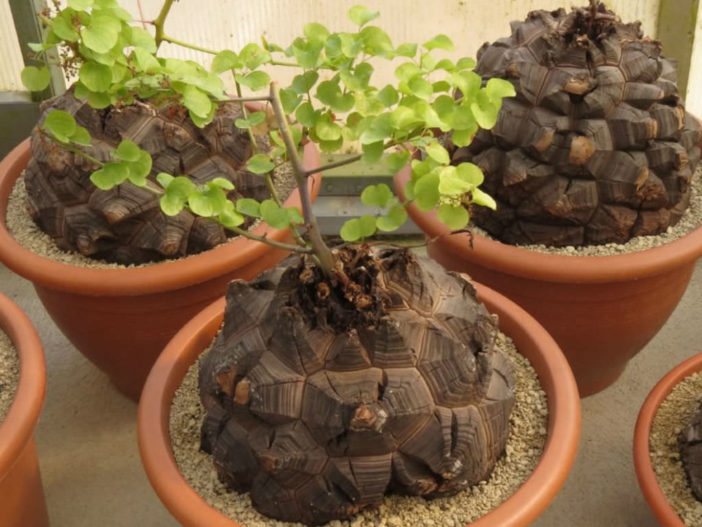
If you are interested in owning one of these weird and wonderful plants, it will be a relief to know that they are extremely easy to care for. So, with this succulent, you get the benefit of a quirky-looking addition to your garden without the hassle that many exotic and quirky plants bring along.
When to Plant Elephant’s Foot
It is best to plant Elephant’s Foot during the warmer seasons of spring and summer.
How to Plant Elephant’s Foot
It is very simple to plant an Elephant’s Foot. It will just need a well-draining pot and well-draining potting soil to be healthy.
Elephant’s Foot Water Requirements
The watering needs of Elephant’s Foot succulents are typical of most succulents. Since they are drought tolerant and designed to store water, they don’t need a lot of liquid. In fact, too much water can cause their roots to rot and the plant to die. If you want to ensure that your Elephant’s Foot succulent get just the right amount of water, then it is best to use the soak and dry method. Also, it is important to not get water on the tuber but only water the soil.
Elephant’s Foot Sun Requirements
Elephant’s Foot succulents are native to the hot, dry areas of South Africa, so if you don’t live in a similar type of environment, you will need to keep your plant in a container that can be brought indoors during the winter or rainy seasons. In the U.S., Elephant’s Foot succulents can be kept outside all year round in Hardiness Zones 9b to 11b.
No matter where you live, it is recommended that these plants should be kept in a warm, sunny area. They like lots of direct sunlight as long as they have been allowed to acclimatize to it. When kept indoors, it is best to set them in a south-facing window so they get as much sun as is possible.
Best Elephant’s Foot Fertilizer
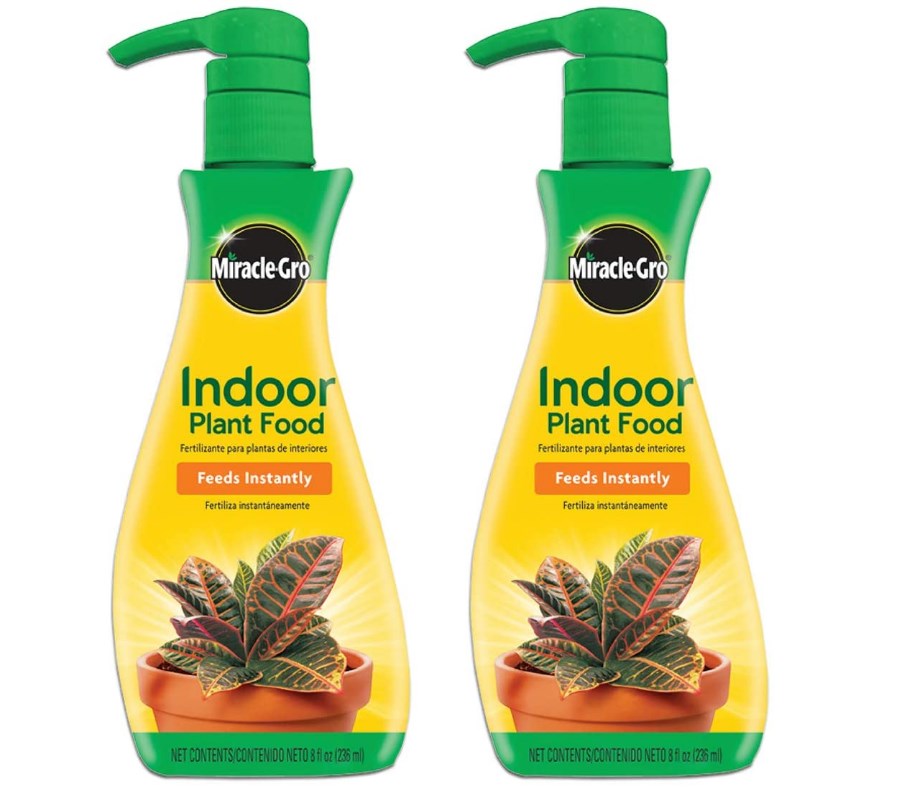
When it comes to feeding an Elephant’s Foot succulent there is a structure that needs to be followed. Don’t worry, this is nothing difficult, but it is necessary so that the plant can grow properly. This is how these particular plants need their food given to them.
- Use a balanced liquid fertilizer such as Miracle-Gro Indoor Plant Food
- Dilute the fertilizer to one-quarter strength of the recommended amount on the package
- Feed the plant once a month during its growing season
- Stop feeding the plant when it goes dormant
Best Elephant’s Foot Companion Plantings
This plant’s odd and unusual look makes it a wonderful addition to gardens and home décor, but it does lack a little color. So, why not compliment this interesting but slightly dullish colored plant with a vibrant companion? Here are just a few options to try:
Moon Cactus
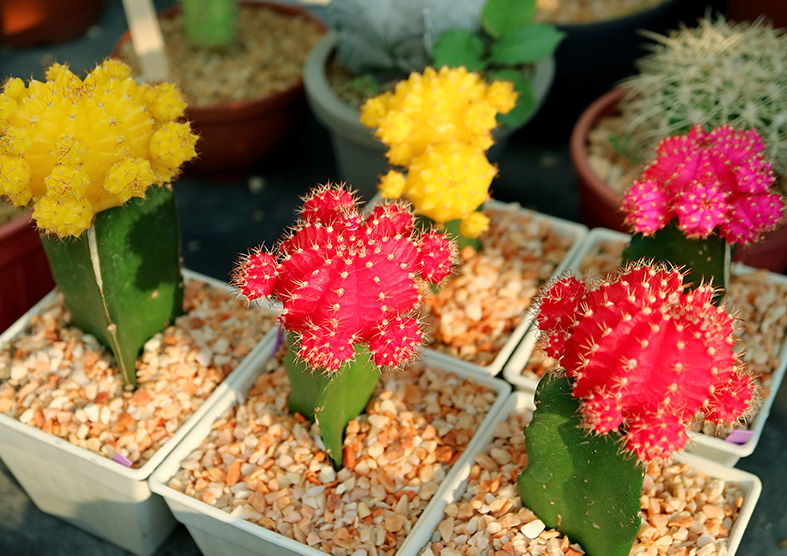
These plants are also unusual looking but are so full of color they will pair perfectly with an Elephant’s Foot.
Pros:
- Bright colorful tops (pink, yellow, red, orange, or purple)
- Compact size (they only grow up to 8 inches in diameter)
- It only needs partial sun
- It only needs fertilizer in the spring and summer
Cons:
- It is a hybrid that does not produce chlorophyll without a rootstock
- It can get root rot easily
Panda Plant
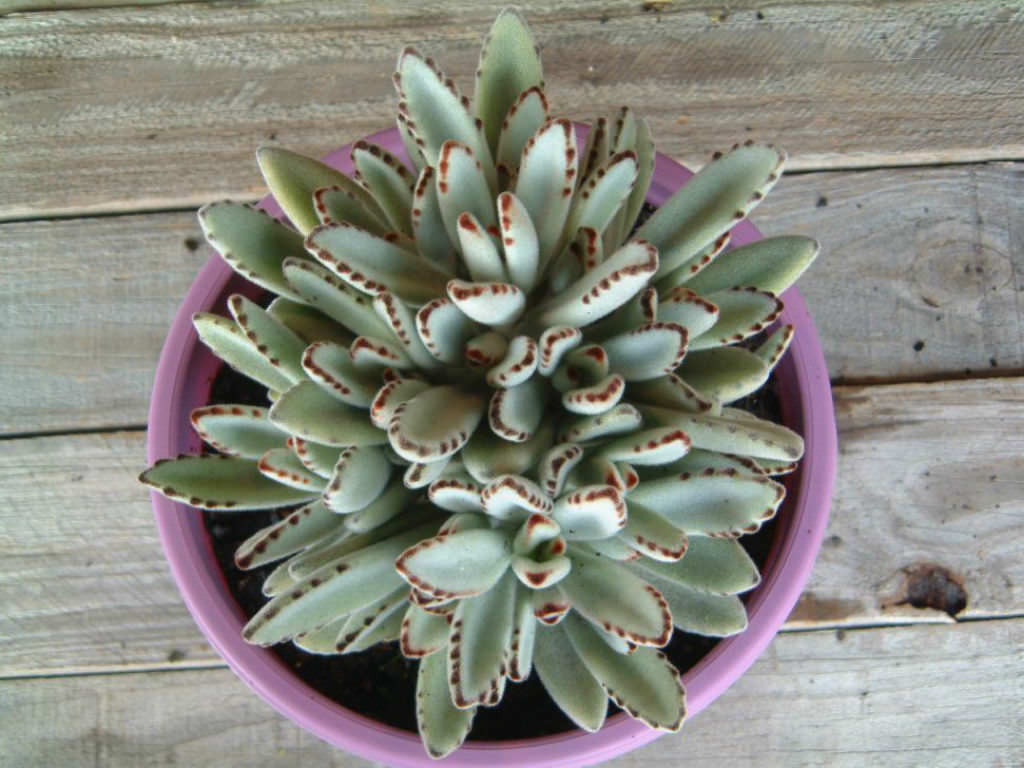
This is an incredibly adorable plant, maybe the most adorable listed. Their leaves are green, fuzzy, and tipped with a chocolate brown; altogether, it does remind one of a panda bear.
Pros:
- It is a plant that is easy to care for
- It is a favorite for children’s rooms
- It does not grow to be very large
Cons:
- It is toxic to animals
- It is easy to overwater
Anacampseros Purple Giant
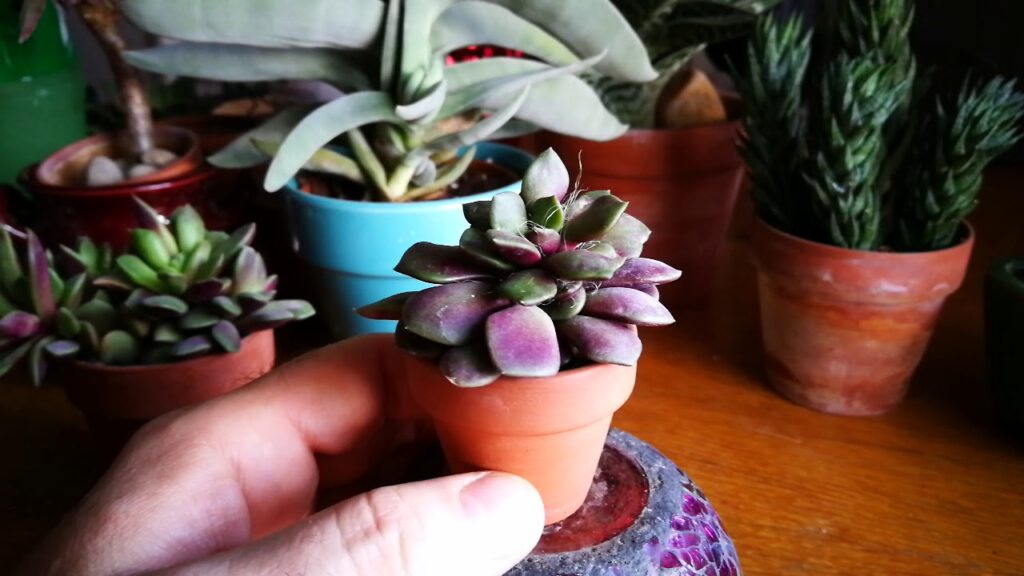
This is another South African native plant that is both beautifully colored and easy to care for. With just the right amount of sunlight, the dark green leaves will give way to deep purple, and eventually, it will produce purple blooms with yellow stamens.
Pros:
- Grows well in indoor containers
- Grows up to 61 centimeters tall and 61 centimeters wide
Cons:
- Does not handle cold temperatures well
- Can be toxic to humans and animals
- Goes dormant in the summer season
Elephant’s Foot Diseases and Common Problems
As is typical with most succulents, Elephant’s Foot succulents can easily get root rot from overwatering them. If you’re concerned that your plant may have root rot, you need to act quickly if there is any chance of saving it. Let’s run through what needs to be done to deal with root rot.
First, you should learn to identify root rot. Here are the basic symptoms of it:
- Roots that have turned dark brown or black
- Stems and/or leaves that are pale, yellow, and mushy
Elephant’s Foot Treatments and Maintenance
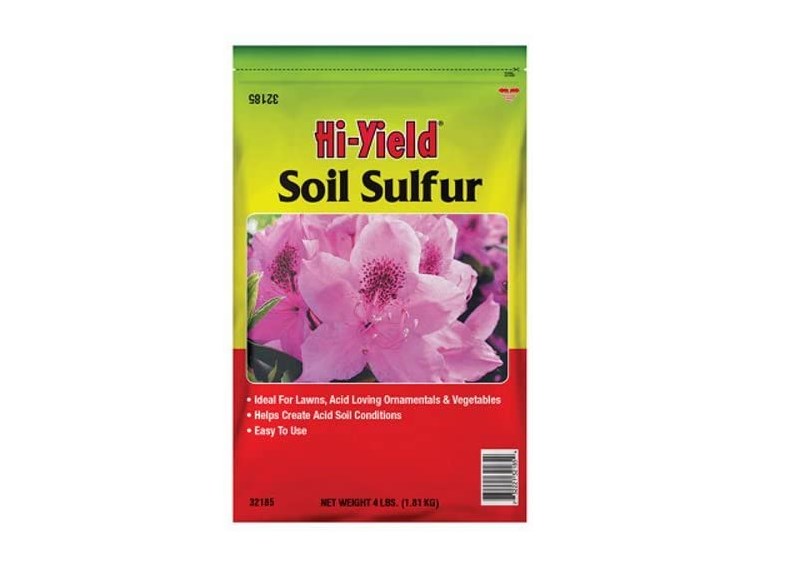
An Elephant Foot that is suffering from root rot will need to be dealt with quickly so that it has any chance of survival. Use these basic treatments to care for it:
Allow the plant to dry out
This technique can be done if the root rot has not spread to the stems. What it entails is taking the plant out of the soil and letting them lay in a dry area for a few days so the excess water will evaporate. Once this has been done, they should be replanted in fresh, clean, and dry soil.
Remove the rotting
This technique will require that you trim off any areas of the plant that are rotting, whether that is in the root system, the stem, or the leaves. Once the trimming is complete, it is absolutely necessary that the plant be allowed to callous for a few days. Without this step, the chances of the succulent surviving are very slim.
Add some sulfur
This technique should be done after the plant has been trimmed of all its rotted areas and allowed to callous. It will require that you dust a little sulfur on its root system to help prevent the spread of microbes.
Behead the plant
This technique is the last resort when it looks like nothing else can be done to save the plant. It is very similar to propagating a new plant and should be handled in much the same way. If this is the method that you feel is necessary for your rotting plant, this video can help you through the process.
As you can see, it is best to prevent root rot rather than have to deal with the consequences of it. Take the time upfront to learn how to properly water and plant your succulents to make sure you don’t have to resort to any of these troublesome methods.
Elephant’s Foot Repotting Instructions
Just as with water needs, these plants are typical succulents when it comes to their soil needs. Elephant’s Foot succulents need soil that is sandy and can drain well. This makes it relatively easy to care for a potted plant or to get it ready for repotting.
These plants don’t mind being crowded in a container, but they do need to be repotted every 3 to 4 years so that they have fresh soil and nutrients. The method for repotting an Elephant’s Foot succulent is simple.
- Select and clean a pot. You can change pots or reuse the same pot.
- Remove the plant from its current pot.
- Discard the old soil.
- Place pebbles, small stones, or clay balls into the bottom of the cleaned pot.
- Fill the pot two-thirds full with succulent potting soil and garden soil.
- Un-clamp the plant’s roots.
- Place the plant on the potting soil and continue filling the pot.
- Tap the plant to make sure it is secure in its new home.
- Water the plant.
Once this has been completed, there will not be any need to water the plant for another 3 to 4 weeks. This will allow it to develop more roots and establish itself in the new environment.
Where to Buy Elephant’s Foot Seeds Online
If you decide that you want to grow one of these from seeds, these online shops are an easy way to get the seeds.
Where to Buy Elephant’s Foot Plants Online
These plants are available at nearly all lawn and garden stores. They may also be available from your local Farmers Market or greenhouses. If these places don’t have a selection that you like, you can also purchase these and any other type of succulent at a reputable online shop.
FAQs
Question: Will Elephant’s Foot Go Through a Time of Dormancy?
Answer: Yes, they will, but learning when an Elephant’s Foot succulent is going dormant can seem a little tedious. However, once you are familiar with how this works, it won’t be a big deal at all. The signs confirming that your Elephant’s Foot succulent is heading into a dormant state and will no longer need fertilizer are when you notice:
- The plant’s vines turn slightly yellow
- The plant’s vines begin to die back
Unfortunately, there is no set season for an Elephant’s Foot succulent to go dormant; in fact, two plants in the same container can go dormant at different times. This means that you will just have to watch for the signs of dormancy in your plant. Once you have confirmed that your plant is in a dormancy phase, you will need to move it to a cool area and cut back on watering.
Question: Are Elephant’s Foot Succulents Known by Any Other Names?
Answer: Yes, in case you are looking for one of these but cannot find it by this name, try using one of its other monikers:
- Dioscorea Elephantipes
- Turtle Back
- Tortoise Back Plant
- Tortoise Shell
- Hottentots’ Bread
- Elephant’s Foot Vine
Question: What is Monoecious?
Answer: This is a strange word that describes how the flowers grow on Elephant’s Foot succulents. What this means is that each plant produces flowers that are either male or female, they do not produce both on one plant. Pollination is done through an intermediary; namely, flies and bees.
Question: Are Elephant’s Foot Succulents Toxic?
Answer: Yes, unfortunately, these plants are toxic to humans and animals. If you have small children or family pets that may try to eat a plant, be sure to keep these types of plants in a location where they cannot be reached. Look for these symptoms if you think a child or a pet has been in contact with an Elephant’s Foot succulent.
- Dizziness
- Nausea
- Sudden tiredness
- Abdominal pain and/or cramps
- Blurred vision
- Vomiting
- Skin irritation
- Purulent inflammation
If you notice these symptoms in a child or animal that has been in contact with an Elephant’s Foot succulent, take the following measures:
- Do not induce vomiting
- Do not give them milk to drink
- Encourage them to drink a lot of water
- Call a doctor or veterinarian depending on who the patient is
- Call a poison control center
Bringing It All Together
We have been able to thoroughly examine the plant known as Elephant’s Foot. In this process, we have seen how unique, strange, and wonderful this succulent is. It is an easy-going and hassle-free plant that can provide a lot of gardening joy. It is an almost indescribable plant with its odd features and growing cycles. If ever there was a succulent that could be described as both peculiar and beautiful, this is it.
If you are in need of a new succulent in your garden area to help bring the look and feel all together, try an Elephant’s Foot. This plant is sure to please even the most reluctant gardeners since it is hardy, low maintenance, uncommon, and highly calming to own. So, give yourself the joy and pleasure of owning one of these natural wonders and sharing it with the world.
Read more interesting and complete guides on how to take care of your plants, below:
- Stapelia Gigantea (Zulu Giant): Plant Care Guide For Beginners
- Pachyphytum Oviferum (Moonstone Succulent): Easy Tips For Plant Care
- Senecio Vitalis (Narrow-Leaf Chalksticks): Care and Growth Guide
- Lophocereus Marginatus (Mexican Fence Post Cactus) - January 10, 2022
- Best Cactus Fertilizer Guide - January 9, 2022
- Selenicereus Grandiflorus (Queen of the Night) - January 3, 2022


